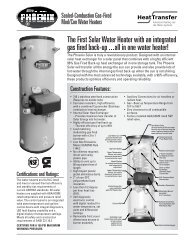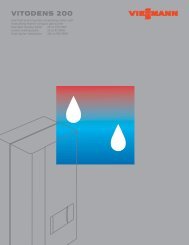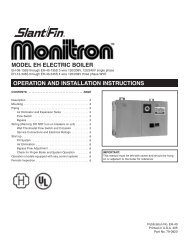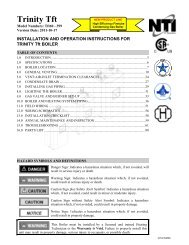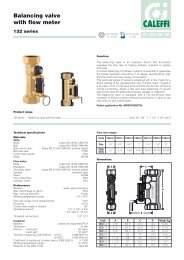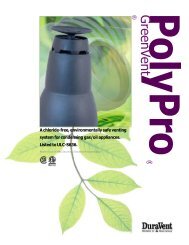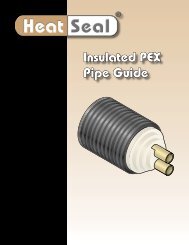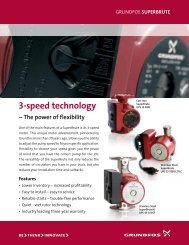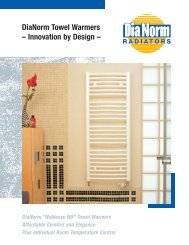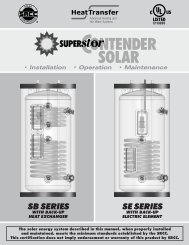Apricus Solar Water Heating System Installation and Operation ...
Apricus Solar Water Heating System Installation and Operation ...
Apricus Solar Water Heating System Installation and Operation ...
Create successful ePaper yourself
Turn your PDF publications into a flip-book with our unique Google optimized e-Paper software.
<strong>Apricus</strong> <strong>Solar</strong> Collector <strong>Installation</strong> & <strong>Operation</strong> Manual - USA3.3. <strong>System</strong> SizingFor residential domestic water heating applications basic rules of thumb exist that depend on local climate <strong>and</strong>can be calculated using the methodology outlined below.For space heating or commercial domestic water heating, system sizing is more complicated. Calculations ofload (energy requirements) <strong>and</strong> solar radiation levels need to be thoroughly analyzed before a system designcan be developed.3.3.1. First Question: How much hot water is needed?a) Rule of thumb:For domestic hot water each adult will use 30 gallons (113 L) per day, each young child another 10 gallons(56 L). For example, a two adult family with three young children can be expected to use 90 gallons of hotwater per day.This rule of thumb is just an example. Adjust this to meet the habits of householders in your local area.b) Calculation:Shower-head flow rate is measured (timed with a bucket or special flow rate device) at 2.5 gpm (9.4 L/min)<strong>and</strong> the family showers for a total of 35 minutes per day = 87.5 gallons.Add hot water usage for the dish washer = 10 gallons.......etcA calculation can then be completed for a specific household based on their expected water usage patterns.c) Tap vs Storage Tank Flow Rate:In the summer months, the solar storage tank can reach temperatures in excess of 160°F (71°C).Therefore, the useful capacity at the tap is increased, because hot water from the tank is being diluted withcold at the Anti-Scald Valve <strong>and</strong>, then, once again at the tap in the house (see diagram below).The flow rate through the faucets is not equal to the flow rate at the tank outlet. While tap hot water volumemaybe be 90 gallons, if the hot water storage tank is 140°F (60°C), only 63 gallons will be drawn from thehot water storage tank, in which case an 80 gallon tank would be suitable.d) Climate:We can estimate based on three types of climate: Cold, Mild & Hot.Cold climates: Freezing winter <strong>and</strong> mild summers.Mild climates: Mild winters with occasional freezing at night <strong>and</strong> fairly hot summers.Hot climates: Warm winters <strong>and</strong> very hot summers.The three key climate factors that location will effect, in terms of the collector output are solar radiationlevels, ambient temperature <strong>and</strong> cold water inlet temperature. Take into consideration that there is massivevariance in these factors from one area to another, even within a single state <strong>and</strong> remember this is only anestimate.Cold regions: Hot water draw from the storage tank will be about 70% of the tap hot water volumeMild regions: Hot water draw from the storage tank will be about 65% of the tap hot water volumeHot regions: Hot water draw from the storage tank will be about 60% of the tap hot water volumeThis variation is due to the difference in incoming cold water temperature, which is mixed with the hot at thetap. The colder the Cold water, the lesser the volume of it necessary to temper the Hot water, hence thegreater percentage of storage tank volume used at the tap in colder regions. <strong>Apricus</strong> provides an Excelbased calculator for accurately calculating the ratio of hot <strong>and</strong> cold water.3.3.2. Second Question: What temperature rise is required?What is the temperature rise that is required within the hot water tank to heat cold water to the st<strong>and</strong>ardoutlet temperature of 140°F (60°C)? (140°F <strong>and</strong> sometimes up to 150°F is required to kill Legionellabacteria).<strong>Apricus</strong> recommends that you calculate for 90% solar contribution for summer months output so as tonot oversize the system.In Cold regions, water will be heated from an average 50°F to 140°F = 95°F rise (10°C to 60°C = 52°C rise)Copyright 2011 – <strong>Apricus</strong> Inc Doc: A7-05.4.1.4-PB-1.9 Page 14 of 126



